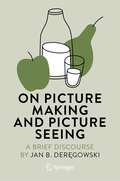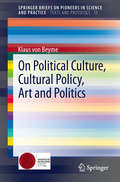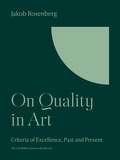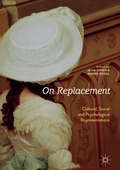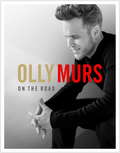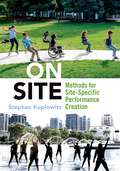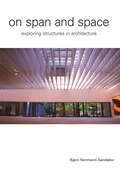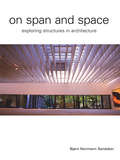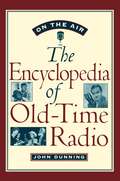- Table View
- List View
On Picture Making and Picture Seeing: A Brief Discourse (Vision, Illusion and Perception #4)
by Jan B. DeręgowskiArchaeological and anthropological investigations of depictions seldom extend beyond a single culture or a single geographical location, although there is a powerful factor common to all depictions, the factor of human perception. In this volume an attempt is made to show how this factor affects both creation and recognition of depictions, how, in common with everyday vision of the environment, typical contours are derived and used, not merely to depict individually readily recognisable models, but also how by concatenation they lead to such a splendid figure as Australian Kakadu crocodiles, or by distortion to creation of illusions of pictorial depth, such as is evoked by Leonardo da Vinci’s perspective and by inverted (Byzantine) perspective thought by some to be an aberration. Bartel’s studies show that pictorial depth is often achieved to the artist’s, and many a viewer’s, but not to geometer’s satisfaction by partial distortion, and Chinese masterpieces embody, side by side, ‘normal’ and inverted perspective. The visual process is universally uniform (if it were not, one would not be able to recognise an Altamira bison as a bison) and its foibles can be freely exploited. Its best known exploiter is probably Cezanne. His pictures are admired by many and puzzle many. Strzemiński postulated that they compound distinct lines of sight, thus endorsing primacy of central vision, a concept thought by Gombrich to be of greater import to geometers than to artists.
On Political Culture, Cultural Policy, Art and Politics (SpringerBriefs on Pioneers in Science and Practice #15)
by Klaus BeymeKlaus von Beyme is a distinguished German political scientist and recipient of the Mattei Dogan Award of Political Science (2012). In honour of his 80th birthday this book addresses political culture, cultural policy, art and politics. The first part on transformation theory analyses: “Historical Memories in Political Theories”, “Historical Memory in Nation-Building and the Building of Ethnic Subsystems”, “The Concept of Totalitarianism – A Reassessment After the Breakdown of Soviet Rule”, “Political Culture – A Concept from Ideological Refutation to Acceptance in the Soviet Social Sciences”, “Institutions and Political Culture in Post-Soviet Russia” and “Political and Economic Consolidation in Eastern Europe. Evidence from Empirical Data”. The second part on cultural policies addresses “Why is There No Political Science of the Arts?”, “Historical Memory and the Arts in the Era of the Avantgardes: Archaisme and Passéisme as a ‘passéisme of the future’”, and “Capital-building in Post-war Germany”.
On Power in Architecture: From a Materialistic, Phenomenological, and Post-Structuralist Perspective (Routledge Research in Architecture)
by Mateja KurirArchitecture has always been a decisive manifestation of power. This volume represents an attempt to question and reflect on the relationship between power and architecture from three philosophical perspectives: materialistic, phenomenological and post-structuralist.This collection opens an interdisciplinary investigation that aims to reflect on architecture and its interconnectedness with power within philosophy and cultural theory at large while presenting these concepts using practical examples from the built environment. Internationally recognised authors – philosophers, architectural theorists and historians – Andrew Benjamin, Andrew Ballantyne, Mladen Dolar, Hilde Heynen, Nadir Lahiji, Jeff Malpas, Dean Komel, Elke Krasny, Robert Pfaller, Gerard Reinmuth, Luka Skansi, Douglas Spencer, Teresa Stoppani and Sven-Olov Wallenstein present their reflections in original unpublished essays and interviews. In the presented works, architecture is combined and transgressed by philosophy in a new discussion that focuses only on power. The contributions in this collection open a variety of architectural questions, one of the central among them being the impact of neoliberal capitalism on architecture. Architecture, with its implications on the complex contemporary political and social reality, is severely changing our space and, more globally, our environment. A reflection on the multilayered relation between architecture and power has never been as topical as it is today.This book will, therefore, be of interest to students, researchers and academics or professionals within the fields of architecture, philosophy, sociology, political sciences and cultural sciences.
On Power in Architecture: From a Materialistic, Phenomenological, and Post-Structuralist Perspective (Routledge Research in Architecture)
Architecture has always been a decisive manifestation of power. This volume represents an attempt to question and reflect on the relationship between power and architecture from three philosophical perspectives: materialistic, phenomenological and post-structuralist.This collection opens an interdisciplinary investigation that aims to reflect on architecture and its interconnectedness with power within philosophy and cultural theory at large while presenting these concepts using practical examples from the built environment. Internationally recognised authors – philosophers, architectural theorists and historians – Andrew Benjamin, Andrew Ballantyne, Mladen Dolar, Hilde Heynen, Nadir Lahiji, Jeff Malpas, Dean Komel, Elke Krasny, Robert Pfaller, Gerard Reinmuth, Luka Skansi, Douglas Spencer, Teresa Stoppani and Sven-Olov Wallenstein present their reflections in original unpublished essays and interviews. In the presented works, architecture is combined and transgressed by philosophy in a new discussion that focuses only on power. The contributions in this collection open a variety of architectural questions, one of the central among them being the impact of neoliberal capitalism on architecture. Architecture, with its implications on the complex contemporary political and social reality, is severely changing our space and, more globally, our environment. A reflection on the multilayered relation between architecture and power has never been as topical as it is today.This book will, therefore, be of interest to students, researchers and academics or professionals within the fields of architecture, philosophy, sociology, political sciences and cultural sciences.
On Quality in Art: Criteria of Excellence, Past and Present (The A. W. Mellon Lectures in the Fine Arts #13)
by Jakob RosenbergAn acclaimed art historian explains how to identify excellence in artIn this book, Jakob Rosenberg takes up the timeless problem of how to make a valid judgment about artistic quality. In his search for criteria of excellence in art, Rosenberg examines both the achievements and failures of other critics from the Renaissance to modern times, including Giorgio Vasari, Roger de Piles, Sir Joshua Reynolds, Théophile Thoré, and Roger Fry. Drawing vital lessons from these critics’ writings, Rosenberg charts an effective approach to the challenges of judging quality in works of art by analyzing master drawings from the fifteenth to twentieth centuries and comparing them with examples of followers or minor contemporaries. The result is a set of practical criteria that are applicable across diverse periods and styles. Brimming with insights from a legendary art critic and historian, On Quality in Art sheds invaluable light on drawings by artists ranging from Dürer, Raphael, Leonardo, Rubens, Rembrandt, Watteau, Degas, and van Gogh to Matisse, Picasso, and Marin.
On Raising a Digital Human: A Personal Evolution (Synthesis Lectures on Computer Science)
by Norman I. BadlerThis book tells the story of building digital virtual human models in the context of the background, choices, and occurrences that shaped the author's own involvement and personal evolution. Such digital models found motivating applications in engineering, anthropology, medical, and group simulation problems, and numerous connections to other disciplines informed and enriched their design, development, and deployment. This personal perspective on developments in the field is enhanced by extensive citations that provide pointers into relevant literature, recognize the contributions of co-authors and collaborators, and give external evidence for claims. Both academic and corporate interest in virtual beings has exploded in recent years, and while this book does not survey the current state of the art it is an essential window into how the field arrived where it is today. The technical discussions throughout the book are deliberately accessible with extensive references to the literature for further reading. This book will be of interest to readers who want to understand the history of virtual human beings, how they evolved, and especially how they must address numerous human characteristics to achieve any sense of "human-ness."
On Replacement: Cultural, Social and Psychological Representations
by Jean Owen Naomi SegalThis book is an interdisciplinary study of the human drama of replacement. Is one’s irreplaceability dependent on surrounding oneself by a replication of others? Is love intrinsically repetitious or built on a fantasy of uniqueness? The sense that a person’s value is blotted out if someone takes their place can be seen in the serial monogamy of our age and in the lives of ‘replacement children’ – children born into a family that has recently lost a child, whom they may even be named after. The book investigates various forms of replacement, including AI and doubling, incest and bedtricks, imposters and revenants, human rights and ‘surrogacy’, and intertextuality and adaptation. The authors highlight the emotions of betrayal, jealousy and desire both within and across generations. On Replacement consists of 24 essays divided into seven sections: What is replacement?, Law & society, Wayward women, Lost children, Replacement films, The Holocaust and Psychoanalysis. The book will appeal to anyone engaged in reading cultural and social representations of replacement.
On Replacement: Cultural, Social and Psychological Representations
by Jean Owen Naomi SegalThis book is an interdisciplinary study of the human drama of replacement. Is one’s irreplaceability dependent on surrounding oneself by a replication of others? Is love intrinsically repetitious or built on a fantasy of uniqueness? The sense that a person’s value is blotted out if someone takes their place can be seen in the serial monogamy of our age and in the lives of ‘replacement children’ – children born into a family that has recently lost a child, whom they may even be named after. The book investigates various forms of replacement, including AI and doubling, incest and bedtricks, imposters and revenants, human rights and ‘surrogacy’, and intertextuality and adaptation. The authors highlight the emotions of betrayal, jealousy and desire both within and across generations. On Replacement consists of 24 essays divided into seven sections: What is replacement?, Law & society, Wayward women, Lost children, Replacement films, The Holocaust and Psychoanalysis. The book will appeal to anyone engaged in reading cultural and social representations of replacement.
On The Road: The real stories on tour (Not A Series)
by Olly MursWant to know what really goes on during an Olly Murs UK tour? Then get the lowdown in my new book, On The Road - the official, uncensored, up close and personal story of 2015's Never Been Better UK adventure. Packed with 200 exclusive pictures, this fly-on-the-wall release captures all the excitement and drama of a 27-gig trip around the country, including the jokes, arguments, heartbreaks and giggles, with some parties thrown in along the way. You could say it's an exclusive insight into all the hard work that goes into putting on a nationwide tour for the best fans in the world. That's not all, though. Keep your eyes peeled for several special guest appearances from the likes of Robbie Williams, Jonathan Ross and the comedians, Russell Brand and John Bishop. One or two Premier League footballers rock up in the story, and I fall victim to a few terrible practical jokes. If that's not enough, there's also the untold story of what really happened when I got the X Factor job.Planes, tourbuses and a helicopter ride or two: On The Road is the access-all-areas tale of my biggest ever headline tour. I promise it's going to give my fans a real insight into what my life's like really behind the scenes - grumps, giggles and all. Don't believe me? Just watch...
On Screen Acting: An Introduction to the Art of Acting for the Screen (Edward Dmytryk: On Filmmaking)
by Edward Dmytryk Jean Porter DmytrykWith On Screen Acting, director Edward Dmytryk and actress Jean Porter Dmytryk offer a lively dialogue between director and actress about the principles and practice of screen acting for film and television. Informal and anecdotal in style, the book spans auditioning, casting, rehearsal, and on-set techniques, and will be of interest to both aspiring and working actors and directors. Originally published in 1984, this reissue of Dmytryk’s classic acting book includes a new critical introduction by Paul Thompson, as well as chapter lessons, discussion questions, and exercises.
On Screen Acting: An Introduction to the Art of Acting for the Screen (Edward Dmytryk: On Filmmaking)
by Edward Dmytryk Jean Porter DmytrykWith On Screen Acting, director Edward Dmytryk and actress Jean Porter Dmytryk offer a lively dialogue between director and actress about the principles and practice of screen acting for film and television. Informal and anecdotal in style, the book spans auditioning, casting, rehearsal, and on-set techniques, and will be of interest to both aspiring and working actors and directors. Originally published in 1984, this reissue of Dmytryk’s classic acting book includes a new critical introduction by Paul Thompson, as well as chapter lessons, discussion questions, and exercises.
On Screen Directing (Edward Dmytryk: On Filmmaking)
by Edward DmytrykWith On Screen Directing, renowned filmmaker Edward Dmytryk distills a lifetime of experience as a director into a dozen short essays on the craft of directing, spanning every stage of the filmmaking process, from screenwriting, preproduction, and casting to set design, postproduction, and promotion. Originally published in 1984, this reissue of Dmytryk’s classic directing book includes a new critical introduction by Bette Gordon and Eric Mendelsohn, as well as chapter lessons, discussion questions, and exercises.
On Screen Directing (Edward Dmytryk: On Filmmaking)
by Edward DmytrykWith On Screen Directing, renowned filmmaker Edward Dmytryk distills a lifetime of experience as a director into a dozen short essays on the craft of directing, spanning every stage of the filmmaking process, from screenwriting, preproduction, and casting to set design, postproduction, and promotion. Originally published in 1984, this reissue of Dmytryk’s classic directing book includes a new critical introduction by Bette Gordon and Eric Mendelsohn, as well as chapter lessons, discussion questions, and exercises.
On Screen Writing (Edward Dmytryk: On Filmmaking)
by Edward DmytrykWith On Screen Writing, director Edward Dmytryk offers a clear, methodical overview of the needs, practices, and problems of screenwriting, including extensive coverage of adaptation. Written In an informal, anecdotal style and using script examples from Hollywood classics, Dmytryk presents a practical set of principles for writing engaging, filmable screenplays. Originally published in 1985, this reissue of Dmytryk’s classic screenwriting book includes a new critical introduction by Mick Hurbis-Cherrier, as well as chapter lessons, discussion questions, exercises, and a glossary.
On Screen Writing (Edward Dmytryk: On Filmmaking)
by Edward DmytrykWith On Screen Writing, director Edward Dmytryk offers a clear, methodical overview of the needs, practices, and problems of screenwriting, including extensive coverage of adaptation. Written In an informal, anecdotal style and using script examples from Hollywood classics, Dmytryk presents a practical set of principles for writing engaging, filmable screenplays. Originally published in 1985, this reissue of Dmytryk’s classic screenwriting book includes a new critical introduction by Mick Hurbis-Cherrier, as well as chapter lessons, discussion questions, exercises, and a glossary.
On Site: Methods for Site-Specific Performance Creation
by Stephan KoplowitzOn Site: Methods for Site-Specific Performance Creation is a practical book for artists and students at all levels who create or are learning to create making sited dance works. Author Stephan Koplowitz covers specific, hands-on strategies for an array of issues to consider before, during, and after embarking upon a project, including site selection, procuring permits, designing the audience experience, researching and exploring a site for inspiration and content, differences in urban and natural environments, definitions of key production roles, building effective collaborations with artists, and techniques to generate site-inspired production elements such as sound/music, costumes, lighting, and media. He also offers helpful chapters on project budgeting, contract negotiation, fundraising, marketing, documentation, and assessment. Based on the author's career spanning over 30 years of site-specific creation, the book also includes the voices of over 24 other artists, producers, and writers who share their perspectives and experiences on the many topics covered. A guide designed to make site work practical, intentional, and attainable, On Site will become a well-worn reference for anyone interested in the creative process and discovering the power of site-specific works.
On Site: Methods for Site-Specific Performance Creation
by Stephan KoplowitzOn Site: Methods for Site-Specific Performance Creation is a practical book for artists and students at all levels who create or are learning to create making sited dance works. Author Stephan Koplowitz covers specific, hands-on strategies for an array of issues to consider before, during, and after embarking upon a project, including site selection, procuring permits, designing the audience experience, researching and exploring a site for inspiration and content, differences in urban and natural environments, definitions of key production roles, building effective collaborations with artists, and techniques to generate site-inspired production elements such as sound/music, costumes, lighting, and media. He also offers helpful chapters on project budgeting, contract negotiation, fundraising, marketing, documentation, and assessment. Based on the author's career spanning over 30 years of site-specific creation, the book also includes the voices of over 24 other artists, producers, and writers who share their perspectives and experiences on the many topics covered. A guide designed to make site work practical, intentional, and attainable, On Site will become a well-worn reference for anyone interested in the creative process and discovering the power of site-specific works.
On Span and Space: Exploring Structures in Architecture
by Bjorn N. SandakerIn this richly illustrated book with many practical examples, Bjorn Sandaker provides readers with a better understanding of the relationship between technology and architecture. As an experienced teacher and writer, Sandaker offers a well-founded aesthetic theory to support the understanding and evaluation of a structure's form and design, examining concepts and viewpoints from both the professions of engineering and architecture. Comprehensively covering structure and aesthetics, this book is ideal for students, professionals and academics in the areas of architecture and building.
On Span and Space: Exploring Structures in Architecture
by Bjorn N. SandakerIn this richly illustrated book with many practical examples, Bjorn Sandaker provides readers with a better understanding of the relationship between technology and architecture. As an experienced teacher and writer, Sandaker offers a well-founded aesthetic theory to support the understanding and evaluation of a structure's form and design, examining concepts and viewpoints from both the professions of engineering and architecture. Comprehensively covering structure and aesthetics, this book is ideal for students, professionals and academics in the areas of architecture and building.
On Surface and Place: Between Architecture, Textiles and Photography (Ashgate Studies in Architecture)
by Peta CarlinOn Surface and Place is a rich and poetic exploration of surfaces which foregrounds their significance in our understanding and experience of place. Adopting weaving as its overarching metaphor, it departs from Gottfried Semper’s discussion of correspondences between architecture and textiles, and emerges from the reading of photographs, a swatch of Harris Tweed and curtain wall façade juxtaposed. In juxtaposing the fabric of the city with the weave of Harris Tweed the book charts an original course across a range of connected ideas and questions, combining many different themes, writers and disciplines. It presents integrated and innovative rethinkings on a number of fundamental relationships, including correlations between body and building, word and image, and between the rural and the metropolitan, and the hand-crafted and the mass-reproduced. In doing so, it seeks to foreground the very interrelationship of surface and place, as it makes a claim for the relational nature of the world in which we live.
On Surface and Place: Between Architecture, Textiles and Photography (Ashgate Studies in Architecture)
by Peta CarlinOn Surface and Place is a rich and poetic exploration of surfaces which foregrounds their significance in our understanding and experience of place. Adopting weaving as its overarching metaphor, it departs from Gottfried Semper’s discussion of correspondences between architecture and textiles, and emerges from the reading of photographs, a swatch of Harris Tweed and curtain wall façade juxtaposed. In juxtaposing the fabric of the city with the weave of Harris Tweed the book charts an original course across a range of connected ideas and questions, combining many different themes, writers and disciplines. It presents integrated and innovative rethinkings on a number of fundamental relationships, including correlations between body and building, word and image, and between the rural and the metropolitan, and the hand-crafted and the mass-reproduced. In doing so, it seeks to foreground the very interrelationship of surface and place, as it makes a claim for the relational nature of the world in which we live.
On Sycamore Gap
by null Kate FoxFrom poet Kate Fox comes a book for everyone who knew the famous silhouette of the tree that stood at Sycamore Gap. For those who took shelter, saw its branches against the sky or heard the leaves dance; for all the picnics next to it and the proposals under it. For anyone who feels the strength of silent roots and the quiet promise of the turning year. For any of us who measure time in rings and wait for green leaves to grow again. For everyone who felt a loss when the gap was just a gap once more, these are words that grew in the space, the hope that shoots like seedlings. Grown against the wide sky of Northumbria, at a place of borders where ancient history meets our modern lives, the tree that stood for so long still has much to say. This is a book of growth, loss and renewal, a song from soil to soul, about how we all live where the earth meets the sky.
On the Aesthetics of Architecture: A Psychological Approach to the Structure and the Order of Perceived Architectural Space (Routledge Library Editions: Ethnoscapes)
by Ralf WeberOriginally published in 1995 as part of the Ethnoscapes: Current Challenges in the Environmental Social Sciences series, reissued now with a new series introduction, On the Aesthetics of Architecture is a result of an interdisciplinary study in architectural theory, psychology and philosophy and the author’s experience as a practicing architect. It tries to relate theories of aesthetics and recent advances in the psychology of visual perception to the practice of design.The text starts with an analysis of traditional and contemporary schools of thought in architectural theory, and then proceeds through the formulation of a general theory of aesthetics based on perceptual and cognitive information processing to a description of the actual conditions under which aesthetic experiences of buildings and cities take place. It exemplifies principles of aesthetic appropriateness through an analysis of architectural space and form.Weber’s book attempts to move the discussion of architectural aesthetics beyond the shifting doctrines of style and the often ambiguous dicta of critics. While the author makes no claim that his interpretation of psychological research will result in good architecture, he does insist on the need to bring the discussion of form back to more objective grounds. As such, it provided a valuable teaching resource and an important new contribution to the discussion among architects themselves, as well as between psychologists, philosophers and art theorists at the time.
On the Aesthetics of Architecture: A Psychological Approach to the Structure and the Order of Perceived Architectural Space (Routledge Library Editions: Ethnoscapes)
by Ralf WeberOriginally published in 1995 as part of the Ethnoscapes: Current Challenges in the Environmental Social Sciences series, reissued now with a new series introduction, On the Aesthetics of Architecture is a result of an interdisciplinary study in architectural theory, psychology and philosophy and the author’s experience as a practicing architect. It tries to relate theories of aesthetics and recent advances in the psychology of visual perception to the practice of design.The text starts with an analysis of traditional and contemporary schools of thought in architectural theory, and then proceeds through the formulation of a general theory of aesthetics based on perceptual and cognitive information processing to a description of the actual conditions under which aesthetic experiences of buildings and cities take place. It exemplifies principles of aesthetic appropriateness through an analysis of architectural space and form.Weber’s book attempts to move the discussion of architectural aesthetics beyond the shifting doctrines of style and the often ambiguous dicta of critics. While the author makes no claim that his interpretation of psychological research will result in good architecture, he does insist on the need to bring the discussion of form back to more objective grounds. As such, it provided a valuable teaching resource and an important new contribution to the discussion among architects themselves, as well as between psychologists, philosophers and art theorists at the time.
On the Air: The Encyclopedia of Old-Time Radio
by John DunningNow long out of print, John Dunning's Tune in Yesterday was the definitive one-volume reference on old-time radio broadcasting. Now, in On the Air, Dunning has completely rethought this classic work, reorganizing the material and doubling its coverage, to provide a richer and more informative account of radio's golden age. Here are some 1,500 radio shows presented in alphabetical order. The great programs of the '30s, '40s, and '50s are all here--Amos 'n' Andy, Fibber McGee and Molly, The Lone Ranger, Major Bowes' Original Amateur Hour, and The March of Time, to name only a few. For each, Dunning provides a complete broadcast history, with the timeslot, the network, and the name of the show's advertisers. He also lists major cast members, announcers, producers, directors, writers, and sound effects people--even the show's theme song. There are also umbrella entries, such as "News Broadcasts," which features an engaging essay on radio news, with capsule biographies of major broadcasters, such as Lowell Thomas and Edward R. Murrow. Equally important, Dunning provides a fascinating account of each program, taking us behind the scenes to capture the feel of the performance, such as the ghastly sounds of Lights Out (a horror drama where heads rolled and bones crunched), and providing engrossing biographies of the main people involved in the show. A wonderful read for everyone who loves old-time radio, On the Air is a must purchase for all radio hobbyists and anyone interested in 20th-century American history. It is an essential reference work for libraries and radio stations.
